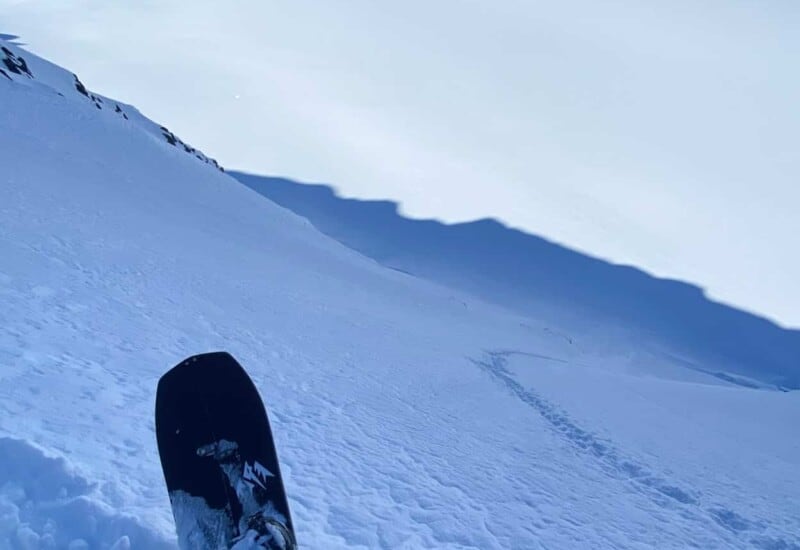Heli-Assisted Backcountry Touring
Snow Unmatched
Access truly remote backcountry terrain in Alaska’s Chugach Mountains, and enjoy authentic alpine touring and splitboarding on our guided, heli-assisted backcountry touring program. Alaska terrain is bigger, badder and has a much deeper snowpack than popular touring areas like Teton Pass and Little Cottonwood Canyon - without the crowds. You’ll access incredible remote terrain, while sleeping in a comfortable bed each night!
Each day your guides will determine the best objectives based upon weather, snow conditions and group dynamics. Some days will be entirely human-powered - for example touring off of Thompson Pass. Other days, we fly your group and guide deep into the Chugach. In each case, you’ll ski some of the most stunning, glaciated mountains on the planet in complete solitude amongst towering peaks, sprawling glacial valleys, and legendary Chugach snow.
“Helicopter assisted” means that you enjoy a scenic flight into the mountains then use your energy for skinning and shredding instead of burning it on the approach. Plus, we access remote terrain that would be nearly impossible to access on foot, far beyond crowds.
This program is for those who seek pristine, challenging terrain and desire to take their backcountry touring skills to higher levels. You’ll ski and ride terrain that few humans will ever see, deep within the mostly unexplored and untouched Chugach Mountains.




Ability & Fitness:
You must be proficient in alpine touring or splitboarding with at least advanced skiing or riding skills and the ability to efficiently descend variable snow conditions.
A high level of fitness and stamina is required for this program to maximize your experience, prevent fatigue, and decrease the potential for injuries. At the time of your trip, you will be expected to be able to ascend up to six thousand vertical feet over the course of a day at a moderate pace. While every day will not be this strenuous, you should be prepared for several longer days in a row.
We’ve created a recommended pre-trip conditioning plan, or you should design your own, similarly rigorous conditioning plan, to ensure peak fitness before arrival in Valdez. (Please check with your doctor before starting any pre-trip conditioning plan).
Groups
To decrease risk, two groups will work together in the field, each with their own guide. Your group members should have similar ability, experience, and objectives. We can combine people to build a group, but ideally you all know each other beforehand.
Terrain:
No place on Earth compares to the Chugach Mountains surrounding Valdez, Alaska. The vast network of sub-ranges, ridgelines, peaks, and glaciers that comprises the Chugach Range makes it a skier’s paradise.
The range stretches more than 250 miles in a crescent shape, from Anchorage in the west to the Copper River in the east with Prince William Sound and the Gulf of Alaska to the south. From Valdez we can access thousands of square miles of rugged mountains in every direction.
Snow:
Premium Quality, Mass Quantity
There’s simply nothing that compares to skiing and riding in the Chugach Mountains. Chugach snow is magical. The powder has been described as silky , smooth, and incredibly forgiving - truly pleasurable. People often ask if Chugach snow is wet and heavy like other coastal mountain ranges, and the answer is definitely not! Average snow conditions range from bottomless dry powder to soft boot-top-deep powder. We invite you to join us in the Chugach and see for yourself.
Valdez is the snowiest place in Alaska and the snowiest incorporated city in the United States, averaging more than 300 inches of snowfall annually. The National Weather Service office at Valdez recorded more snowfall from July 1985 through June 2015 than any other location in Alaska (725 feet). During a two-day period in 2013, Valdez recorded more than 10 feet of snowfall. Thompson Pass, located at mile 26 of the Richardson Highway east of Valdez, averages about 46 feet of snowfall annually at 2,700 feet above sea level.
Snow accumulation is far more extreme in the surrounding glaciated Chugach Mountains where we go skiing, with an estimated 30 meters (100 feet) of annual accumulation.
Massive glaciation makes all the difference. Nearly everywhere we ski is glaciated or near glacial ice, and this creates a cooling effect that enhances snowfall and the quality of the snow.

